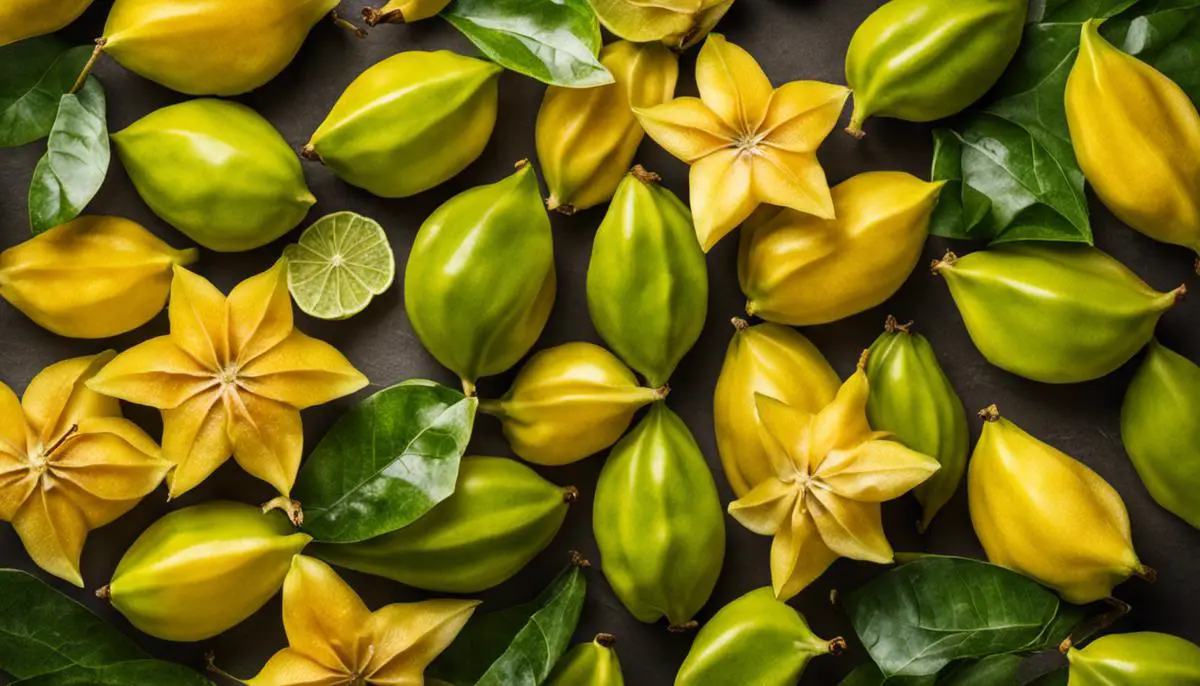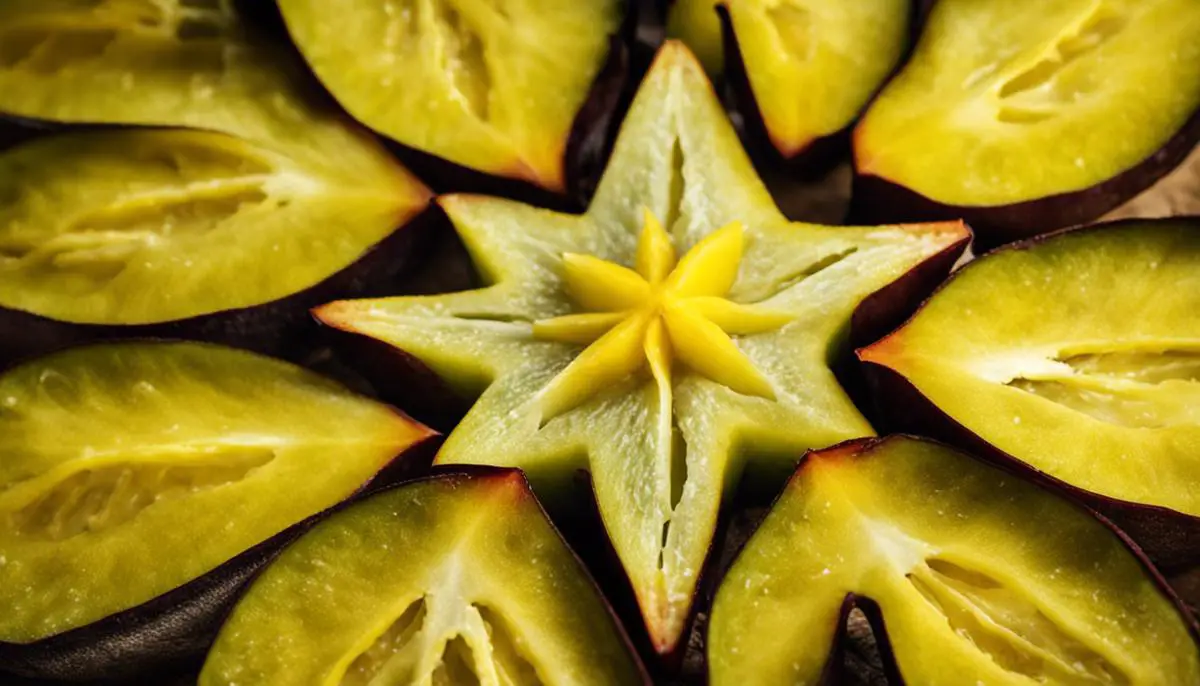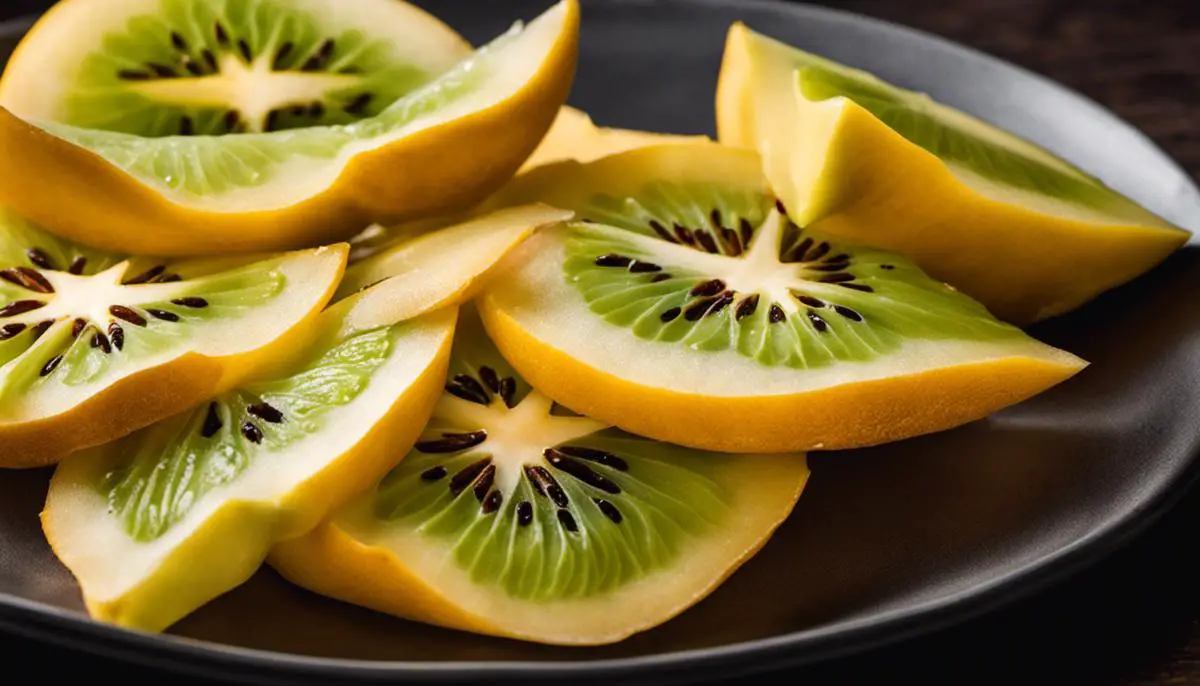In recent years, people are becoming increasingly cognizant of the role that nutrition plays in maintaining good health. Among the variety of fruits that show mind-boggling benefits, one that particularly stands out is Carambola, more commonly known as star fruit. Its unique taste and star-shaped appearance make it a favorite among many, but beyond its aesthetic appeal and pleasing flavor, the star fruit holds an array of nutritional benefits. Especially notable is its potential for enhancing eye health, a topic that warrants a meticulous exploration considering the growing cases of eye issues across the globe. With rich supplies of vitamins and various other nutrients, the star fruit might indeed be a superstar in eye health.
Understanding Carambola (Star Fruit)
Understanding Carambola or Star Fruit
Carambola, widely recognized as star fruit, is a yellowish tropical fruit with an edible skin and uniquely star-shaped cross-section, hence the name. The star fruit’s official name is Averrhoa Carambola. This fruit is native to Asia, particularly the Philippines, Indonesia, Malaysia, India, Bangladesh, and Sri Lanka. Despite being tropical, certain cultivars can tolerate temperatures down to 20 degrees Fahrenheit.
Star fruit is used broadly in cooking for its sweet and tangy flavor and as a garnish due to its distinct star-like shape when cut crosswise. This juicy fruit can range from 2.5 to 6 inches long, with convex elongated edges forming the star profile.
Nutritional Composition of Carambola
The star fruit is rich in antioxidants, flavonoids, and Vitamin C, contributing to its reputation as a health-boosting fruit. But what sets star fruit apart from fellow tropical fruits is its impressive concentration of essential nutrients, particularly of B-Vitamins such as folate and riboflavin, as well as minerals like potassium, phosphorus, and zinc. A hundred-gram serving of raw star fruit contain around 41 calories, 10.4 grams of carbohydrates, 2.8 grams of fiber, and 0.4 grams of fat.
How Carambola Benefits the Eyes
The star fruit’s high Vitamin A, C content, and antioxidants are great for eye health. Vitamin A plays a critical role in maintaining the surface of the eyes and helps protect against age-related macular degeneration, cataracts, and other eye issues. On the other hand, Vitamin C has been linked to reducing the risk of cataracts and promoting healthy ocular blood vessels.
The star fruit also has a high concentration of antioxidants, including gallic acid, quercetin, and epicatechin. These compounds combat oxidative stress, a main actor in the etiology of many eye diseases.
Fiber is another nutrient found in star fruits that assists with ocular health. Dietary fiber can aid in lowering the chance of macular degeneration by stemming the progression of the condition.
Another important component is the fruit’s high water content, which can help fight dry eye syndrome by keeping the body and, therefore, the eyes hydrated.
Important Cautions for Individuals with Kidney Troubles
While star fruit is known for its significant health advantages, including benefits to eye health, it can present potential hazards for people battling kidney conditions or undergoing kidney dialysis. This is primarily due to the fruit’s high oxalic acid content, which could promote kidney stone formation. In addition, star fruit contains a neurotoxin that can potentially harm the brain and nerves, leading to neurologic disorders. This makes the fruit dangerous for individuals with kidney disease, as their bodies may struggle to eliminate these toxins effectively.

Carambola and Eye Health
Diving into the Nutritional Content of Carambola Star Fruit
Known also as star fruit due to its unique star-like shape when cut, Carambola boasts an impressive array of essential nutrients positively impacting general health, including eye health. Vitamin A and Vitamin C, both crucial for maintaining good eye health, are found in large quantities in this fruit. For size reference, a medium-sized star fruit can deliver up to 29 percent of the daily recommended intake of Vitamin A and a significant 76 percent of the daily Vitamin C recommendation.
Role of Vitamin A in Eye Health
Vitamin A is widely recognized for its role in maintaining good vision and eye health. It forms a component of the protein rhodopsin, which helps the retina to absorb light. A deficiency of this vitamin can lead to a condition known as night blindness, where it becomes difficult to see in low light or darkness. Vitamin A can also help in the prevention of macular degeneration and cataracts, both of which can cause significant vision impairment and are leading causes of blindness in older adults.
Vitamin C: An Antioxidant Powerhouse for Eye Health
Vitamin C on the other hand, is a powerful antioxidant that can help to combat the damaging effects of free radicals on the cells of the eyes. Oxidative stress is one of the factors that contribute to eye diseases such as age-related macular degeneration and cataracts. By including star fruit in your diet, you’re bolstering your eyes’ defense against oxidative stress.
Impact of Fiber and Hydration on Eye Health
Beyond vitamins A and C, star fruit is also high in fiber and water content. While they may not directly impact vision, they contribute to overall eye health. Hydration is essential for maintaining the eye’s vitreous humor, a clear, jelly-like substance in the eye. This is necessary for maintaining shape and optimal function of the eye. Fiber, while not directly contributing to vision, aids in overall health and efficient digestion which could indirectly affect eye health.
Balancing Star Fruit Consumption for Optimal Eye Health
While the benefits of star fruit to eye health are substantial, it’s also worth noting that consuming it in moderation is key. Individuals with kidney issues should limit or avoid star fruit, as it contains oxalic acid, which may form crystals and lead to kidney stones or worsen kidney disease. As with any health advice, individual dietary needs and restrictions should be taken into account. Always consult with a healthcare provider for personalized advice.
Rich in vitamin A and C, the carambola star fruit significantly contributes to eye health maintenance and improvement. Whether you choose to enjoy it raw, in a salad, or juiced, incorporating this unique fruit into your diet can result in notable enhancements in your eye health, reducing the risk of vision complications in the process.

Star Fruit vs Other Eye-Boosting Fruits
Comparing Carambola Star Fruit with Other Fruits in terms of Eye Health Benefits
Out of the many health benefits offered by the carambola star fruit, its potential for improving eye health stands out. However, when set against other fruits known for their eye health benefits such as oranges, strawberries, and grapes, the star fruit presents a unique set of advantages and a few drawbacks worth considering.
Advantages of Carambola Star Fruit for Eye Health
Star fruit is rich in antioxidants, particularly Vitamin C, which is known to prevent or slow age-related macula degeneration, and reduce the risk of cataracts and other vision disorders. And not just Vitamin C, star fruit is also packed with other vital nutrients like Vitamin A, fiber, copper, potassium, and the antioxidants quercetin, gallic acid, and epicatechin, all of which can help improve overall eye health.
Compared to grapes and strawberries, the Vitamin C content in star fruit is considerably high, which can contribute to maintaining the health of your ocular blood vessels. Likewise, the star fruit’s copper content is an integral part for the production of collagen, a protein that offers structure and elasticity to the cornea of the eye.
Limitations of Carambola Star Fruit for Eye Health
Despite the many benefits, star fruit also has its limitations. For instance, it lacks specific eye-healthy nutrients such as lutein and zeaxanthin which are found abundantly in fruits like oranges. These nutrients are vital for overall eye health and preventing conditions like age-related macular degeneration and cataracts.
Furthermore, individuals with kidney issues should avoid star fruit, as it contains high levels of oxalic acid that could lead to the formation of kidney stones. This could lead to kidney-related health complications, which can indirectly affect your eye health.
Seeing Stars: The Role of Star Fruit in Eye Health
Though it shouldn’t be regarded as a complete solution for eye health, star fruit forms a crucial part of a comprehensive vision care routine. It is important to remember that no single food, including star fruit, can ensure the total health of your eyes. A mixture of nutrient-rich foods should feature in your balanced diet, along with regular exercise and consistent eye check-ups.
Moreover, it should be noted that while the intake of star fruit offers several possible advantages to eye health, individual dietary requirements can vary. Hence, before incorporating large portions of star fruit into your meal plan, especially if you have pre-existing health conditions or are on medication, speaking to a healthcare professional is highly advisable.

How to Incorporate Star Fruit into Your Diet
Twinkle, Twinkle, Little Star Fruit: An Incredible Ally for Vision
The Tropics gift us with the Carambola, or as it is more affectionately called, the star fruit. This fruit, celebrated for its distinctive star-like shape, has been thrust into the health spotlight recently for its multitude of potential benefits, including those relating to eye health. Beyond its infusion of vibrant color and exquisite taste to your meals, the star fruit brings along a host of nutrients deemed particularly beneficial for preserving and improving the health of your eyes.
Packed Full of Vital Nutrients for Strong Vision
Star fruit is laden with essential nutrients that promote and support eye health. It contains plant compounds like polyphenols, quercetin, gallic acid, and epicatechin — all of which have antioxidant properties that help protect the eyes from harmful free radicals. These antioxidants play a critical role in reducing the risk of developing cataracts and macular degeneration, two common eye disorders that can lead to vision loss.
Aside from antioxidants, star fruit also boasts considerable amounts of Vitamin A and Vitamin C. Vitamin A, in particular, is crucial for maintaining eye health since it helps protect the eye surface. It forms a part of the protein rhodopsin that allows the eye to absorb light, thus promoting better night vision. On the other hand, Vitamin C can reduce the risk of cataracts, slow the progression of age-related macular degeneration, and contribute to the prevention of other visual problems.
Safe Ways to Incorporate Star Fruit into Regular Diet
Incorporating star fruit into your daily nutrition can be as simple or as innovative as you want. It can be consumed raw, to enjoy its sweet-tart flavor and high fiber content. You can add slices of it to salads or use as garnish for seafood dishes. Star fruit can also be juiced or blended into smoothies, providing a refreshing twist to your beverages. Sweet dishes aren’t left behind as it can be baked into pies or made into jellies and jams.
If you’re thinking about creating a more extensive meal plan, star fruit pairs well with a variety of ingredients in main courses. A simple yet delectably healthy recipe to try is a grilled chicken and star fruit salad. For dessert, star fruit upside-down cake is an exciting choice that lends a tropical vibe to the dinner table. Another interesting recipe is the star fruit and mango chutney, an excellent accompaniment to roast meat or fish.
Remember, moderation is key when incorporating star fruit into your diet as consuming it excessively can lead to kidney problems, particularly in those with kidney diseases. Individuals on medications should also consult their healthcare provider before including star fruit in their diet, as it can potentially interfere with certain drugs.
Incorporating Carambola Star Fruit Into Your Routine for Better Eye Health
The tropical carambola star fruit shines brightly in any dietary plan due to its nutrient-dense profile, which offers an abundance of beneficial compounds for eye health. Choosing this exotic superstar alongside a balanced meal plan can be a game changer for maintaining optimal vision. Yet, it’s equally important to remember that regular eye examinations and an overall healthy lifestyle are critical for maintaining the best results.

Side Effects and Precautions
Carambola Star Fruit: A Powerhouse of Nutrients for Vision Health
The exotic carambola star fruit, scientific name being Averrhoa carambola, is held in high regard for its unique star-like appearance and nutrient-rich profile, which is particularly beneficial for the eyes. Its richness in vitamins A and C, powerful antioxidants, enables them to shield the eyes from destructive free radicals.
Vitamin A is particularly vital for the health of your eyes as it forms a part of the protein rhodopsin, which is instrumental in light perception. A lack of vitamin A can result in problems such as night blindness. Conversely, vitamin C has displayed promising results in decreasing the chances of developing conditions such as cataracts and macular degeneration, which are common threats to vision leading to blindness if left untreated.
Additionally, star fruit is a good source of flavonoids that help combat inflammation in the eyes. It has been suggested that these antioxidants aid in reducing risks of diseases like age-related macular degeneration, cataracts and even glaucoma. The abundant presence of beta-carotene and polyphenols in carambola further enhances its status as a trove of compounds conducive to overall eye health.
Potential Side Effects and Risks of Consuming Carambola Star Fruit
While carambola star fruit can be beneficial, it’s crucial to be aware of the potential side effects and risks associated with its consumption, particularly in excess. The fruit contains a neurotoxin that can affect the nervous system and cause neurologic disorders. This toxin may lead to hiccups, confusion, seizures, and can even cause coma and death in extreme cases.
People with kidney problems, in particular, should exercise caution when consuming star fruit. This is because their kidneys are less capable of processing the neurotoxin present in the fruit. Likewise, those who take prescriptions or other medications should consult their healthcare provider before consuming the fruit, as it could interact with certain drugs.
Precautions and Guidelines for Consuming Carambola Star Fruit
While star fruit offers numerous health benefits, certain individuals should take precautions before incorporating it into their diet. Individuals with kidney disease or other renal problems, those who are prone to kidney stones, and people taking medications that can interact with the fruit should consult with a healthcare provider before consuming star fruit.
Consuming moderate amounts of star fruit and maintaining a balanced diet is key to reaping its health benefits without triggering the associated risks. It’s recommended to seek medical advice for personalized recommendations based on one’s health status and needs.
To sum up, carambola star fruit carries potential benefits for eye health due to its rich content of antioxidants like vitamin A and C, flavonoids, beta-carotene, and polyphenols. However, potential adverse effects, especially for individuals with specific health conditions, must be considered. As with any dietary changes, consultation with a medical professional is the best course of action for safe consumption.

While star fruit clearly holds some advantages for eye health with its rich vitamin content, it is also crucial to acknowledge that there can be potential risks and side effects associated with its consumption, especially when done excessively or by individuals with specific health conditions. Always remember, moderation is key to reaping maximum benefits and causing least harm to your health. Incorporate star fruit into your diet wisely and enjoy not only the distinct falvour it offers but also the eye-related health benefits it holds. With prudence and balance, the variety of our mother nature’s bounty can be used not just for our gastronomical pleasure, but also for a healthier life and a clearer vision.
